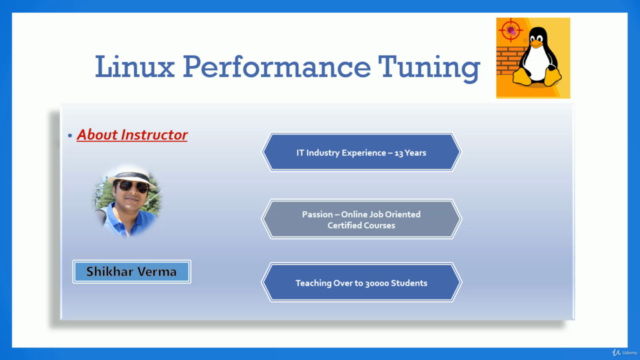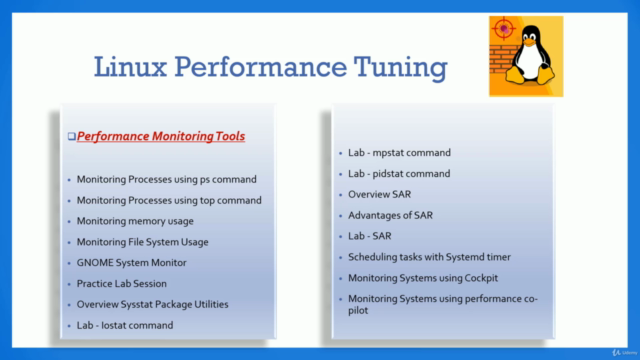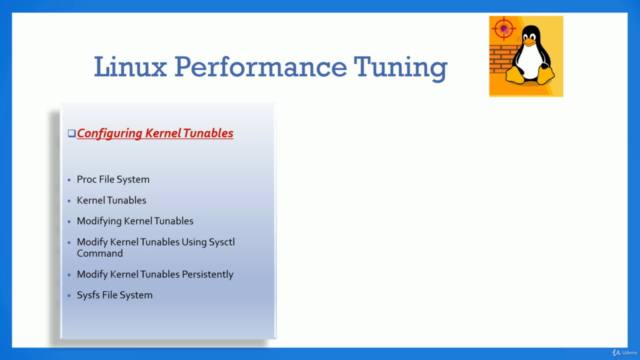Linux Performance Monitoring & Analysis - Hands On !!

Why take this course?
🎓 [Linux Performance Monitoring & Analysis] 🚀
Unlock the Secrets of Linux Server Administration! 🧑�💻
🎉 Course Highlight:
Dive into the world of Linux performance monitoring and analysis with our comprehensive online course. This hands-on learning experience is designed to equip you with the essential skills needed to become an in-demand Linux Server Administrator. You'll learn from real IT professionals who will guide you through live Environment Sessions, ensuring you gain practical knowledge that you can apply immediately.
Course Contents:
🚀 Introduction to Performance Monitoring in Linux:
-
🔍 Monitoring Processes:
- Using
psandtopcommands - GNOME System Monitor for real-time system monitoring
- Practice Lab Session
- Using
-
🛠️ Sysstat Package Utilities Overview
iostat,mpstat,pidstatlabs- Introduction to
SAR(System Activity Reporter) - Advantages of using
SAR - Hands-on with
SARcommands
-
⏱️ Scheduling Tasks with Systemd timer
-
💡 Monitoring Systems with Cockpit & Performance Co-Pilot
Performance Statistics with sar Command:
- Collective and individual CPU usage
- Memory and swap space utilization
- I/O activities overview
- Run queue and load average data analysis
- Network statistics insights
- Reporting sar data from a specific time
Viewing Hardware Resources:
- 🔗 Kernel Messages with
dmesg - CPU Information Retrieval
- DMI information using
dmidecode - Peripheral details exploration
- System hardware overview with
hwlocandlshw
Configuring Kernel Tunables:
- Proc File System deep dive
- Understanding and modifying kernel tunables
- Sysctl command for dynamic changes
- Persistent tunable modifications
- Introduction to tuning profiles
- Practical lab sessions on setting limits for services
Process Management:
- Command line process status and control with
ps - Interpreting different states like "D", "S", "T", "Z"
- Process termination using kill commands
- Hands-on practice session
Mastering Linux Find Commands:
- File searching by name, permissions, owners, groups, date, time, and size
- Real-world application scenarios
Top Running Processes:
- Identifying memory and CPU intensive processes
- Using
lsofandfuserfor in-depth analysis
Practical Lab Sessions:
- Case studies on high CPU and memory utilization issues
- Interactive lab exercises to reinforce learning
Why Enroll?
- Real-World Experience: Gain hands-on experience with real Linux systems.
- Expert Instructors: Learn from experienced Linux professionals who understand the intricacies of performance monitoring and analysis.
- Interactive Labs: Engage in practical exercises to solidify your knowledge.
- Career Advancement: Acquire skills that are highly sought after by tech companies worldwide.
- Community Support: Join a community of learners who share your passion for Linux and system administration.
👨🎓 Enroll Now to Start Your Journey Towards Mastering Linux Performance Monitoring & Analysis! 🔍✨
Don't miss out on this opportunity to become an expert in Linux performance tuning. Sign up today and take the first step towards a rewarding career in system administration! 🚀🌟
Course Gallery




Loading charts...
Comidoc Review
Our Verdict
While there are minor discrepancies in the course information and improvement possibilities, this 5-hour Linux Performance Monitoring & Analysis course offers practical hands-on experience with a wide range of monitoring tools and essential commands. Ideal for beginners with basic Linux knowledge aspiring to improve their system administration skills.
What We Liked
- Comprehensive coverage of Linux performance monitoring tools like top, vmstat, iostat, free, lsof, and tcpdump
- Practical knowledge gained through real-world examples and live sessions with IT experts
- Detailed explanation of essential Linux commands, such as sar, ps, and find, while providing unique examples
- Dedicated sections for vital metrics including CPU, memory, disk I/O, network usage, and kernel tunables
Potential Drawbacks
- Minor inconsistencies in information presented, such as firewalld rule reloading and the use of ifconfig
- Lack of deeper analysis on certain concepts like VSZ, RSS, niceness, and priority in top command output
- Occasional repetitiveness and room for improvement in connecting theoretical knowledge to real-world scenarios
- Suboptimal audio quality with background noises in some sessions